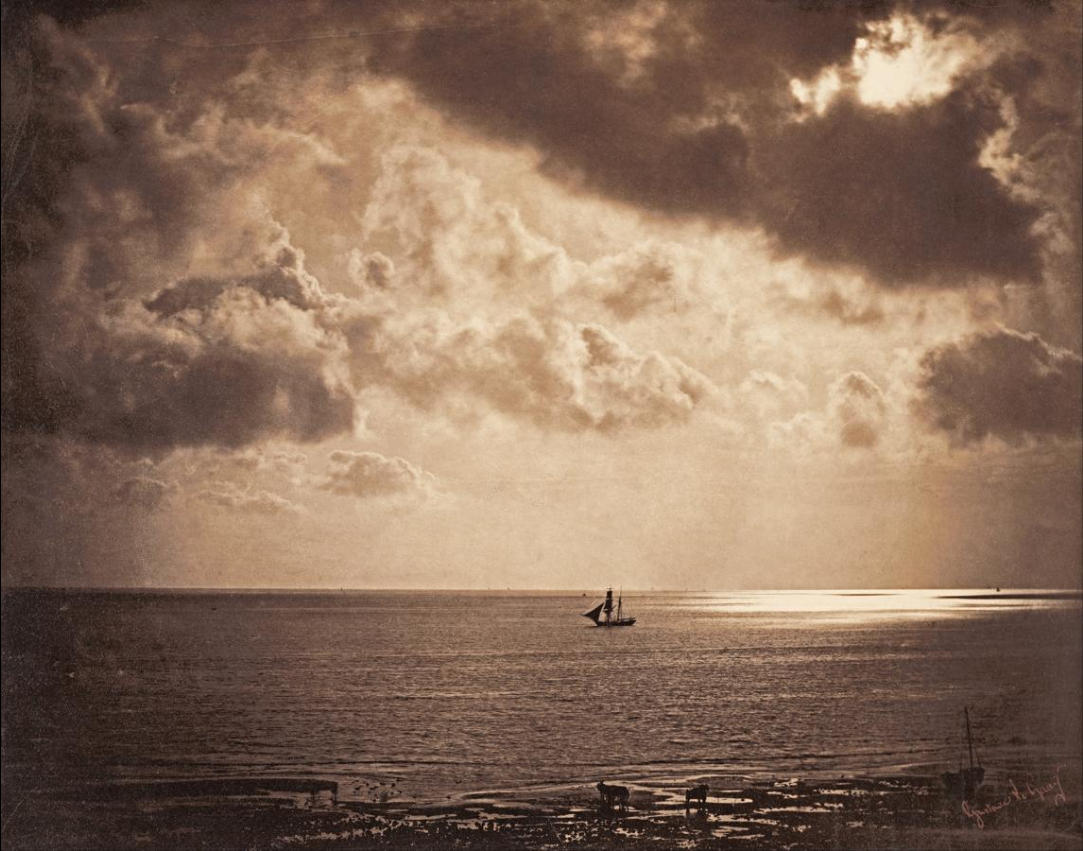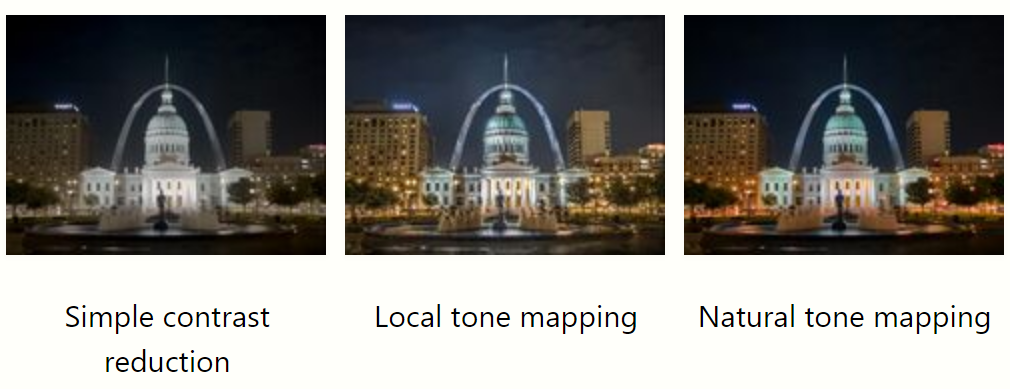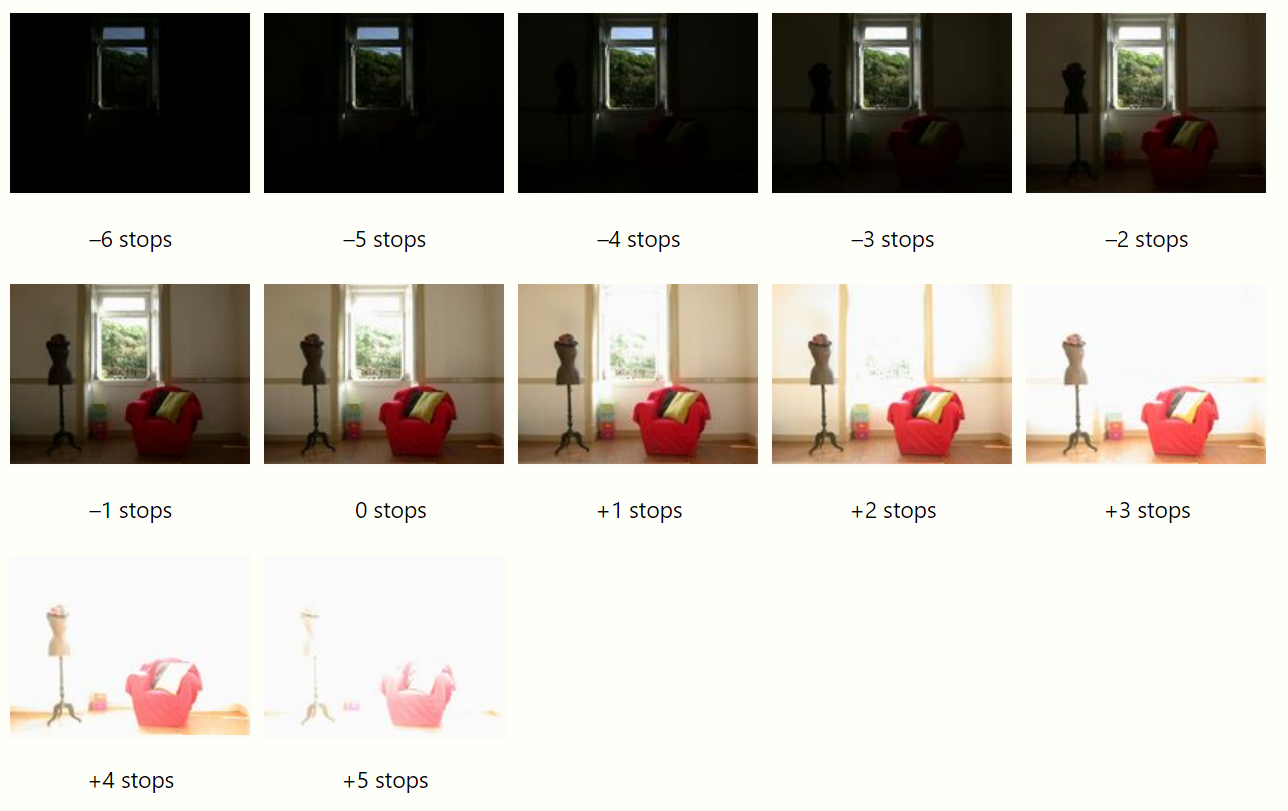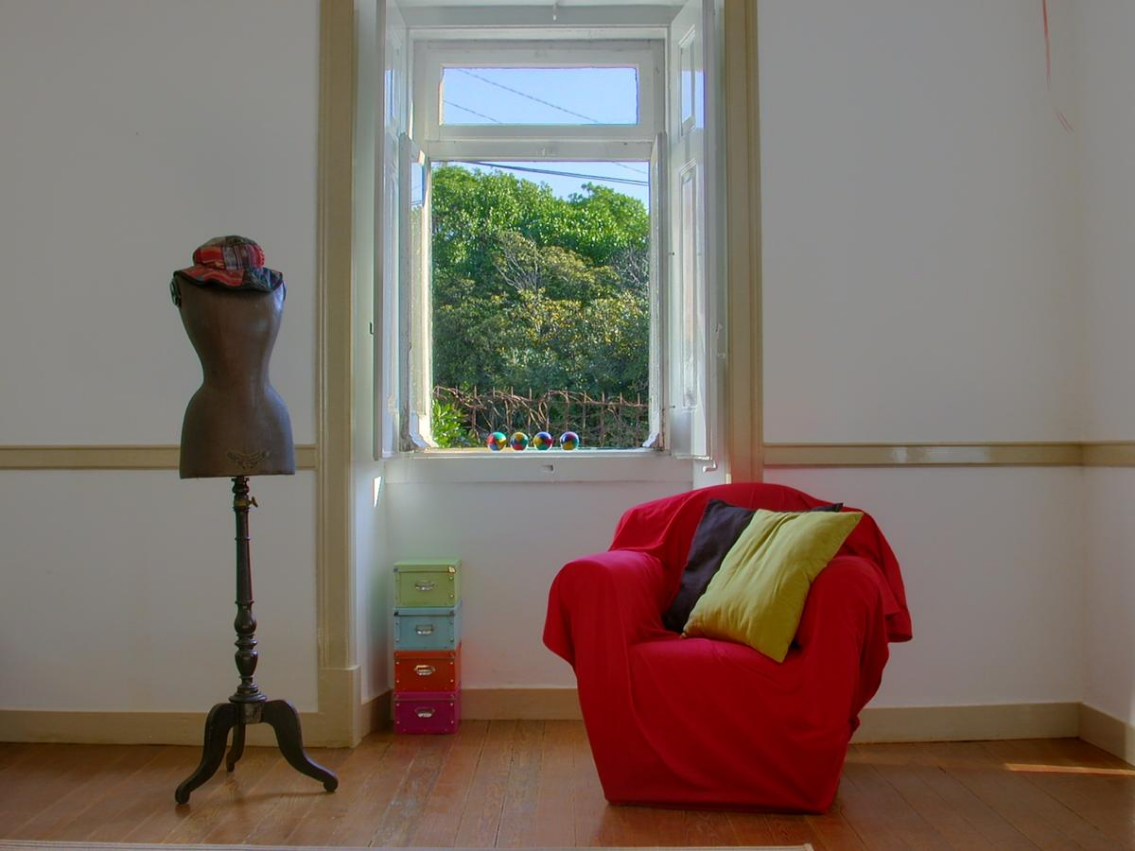
| Version | Summary | Created by | Modification | Content Size | Created at | Operation |
|---|---|---|---|---|---|---|
| 1 | Sirius Huang | -- | 2779 | 2022-10-27 01:37:58 |
Video Upload Options
In photography and videography, HDR or high-dynamic-range imaging is the set of techniques used to reproduce a greater range of luminosity than that which is possible with standard photographic techniques. Standard techniques allow differentiation only within a certain range of brightness. Outside this range, no features are visible because in the brighter areas everything appears pure white, and pure black in the darker areas. The ratio between the maximum and the minimum of the tonal value in an image is known as the dynamic range. HDR is useful for recording many real-world scenes containing very bright, direct sunlight to extreme shade, or very faint nebulae. High-dynamic-range (HDR) images are often created by capturing and then combining several different, narrower range, exposures of the same subject matter. The two primary types of HDR images are computer renderings and images resulting from merging multiple low-dynamic-range (LDR) or standard-dynamic-range (SDR) photographs. HDR images can also be acquired using special image sensors, such as an oversampled binary image sensor. Due to the limitations of printing and display contrast, the extended luminosity range of input HDR images has to be compressed to be made visible. The method of rendering an HDR image to a standard monitor or printing device is called tone mapping. This method reduces the overall contrast of an HDR image to facilitate display on devices or printouts with lower dynamic range, and can be applied to produce images with preserved local contrast (or exaggerated for artistic effect). "HDR" may refer to the overall process, to the HDR imaging process, or to HDR imaging represented on a low-dynamic-range display such as a screen or standard .jpg image.
1. Emulating the Human Vision System
One aim of HDR is to present a similar range of luminance to that experienced through the human visual system. The human eye, through non-linear response, adaptation of the iris, and other methods, adjusts constantly to a broad range of luminance present in the environment. The brain continuously interprets this information so that a viewer can see in a wide range of light conditions.
Standard photographic and image techniques allow differentiation only within a certain range of brightness. Outside of this range, no features are visible because there is no differentiation in bright areas as everything appears just pure white, and there is no differentiation in darker areas as everything appears pure black. Non-HDR cameras take photographs with a limited exposure range, referred to as low dynamic range (LDR), resulting in the loss of detail in highlights or shadows.
2. Photography
| Device | Stops | Contrast ratio | |
|---|---|---|---|
| Single exposure | |||
| Human eye: close objects | 07.5 | 00150...200 | |
| Human eye: 4° angular separation | 13 | 08000...10000 | |
| Human eye (static) | 10...14 [1] | 01000...15000 | |
| Negative film (Kodak VISION3) | 13 [2] | 08000 | |
| 1/1.7" camera (Nikon Coolpix P340) | 11.9 [3] | 03800 | |
| 1" camera (Canon PowerShot G7 X) | 12.7 [3] | 06600 | |
| Four-thirds DSLR camera (Panasonic Lumix DC-GH5) | 13.0 [3] | 08200 | |
| APS DSLR camera (Nikon D7200) | 14.6 [3] | 24800 | |
| Full-frame DSLR camera (Nikon D810) | 14.8 [3] | 28500 | |
In photography, dynamic range is measured in exposure value (EV) differences, known as stops. An increase of one EV, or one stop, represents a doubling of the amount of light. Conversely, a decrease of one EV represents a halving of the amount of light. Therefore, revealing detail in the darkest of shadows requires high exposures, while preserving detail in very bright situations requires very low exposures. Most cameras cannot provide this range of exposure values within a single exposure, due to their low dynamic range. High-dynamic-range photographs are generally achieved by capturing multiple standard-exposure images, often using exposure bracketing, and then later merging them into a single HDR image, usually within a photo manipulation program.
Any camera that allows manual exposure control can make images for HDR work, although one equipped with auto exposure bracketing (AEB) is far better suited. Images from film cameras are less suitable as they often must first be digitized, so that they can later be processed using software HDR methods.
In most imaging devices, the degree of exposure to light applied to the active element (be it film or CCD) can be altered in one of two ways: by either increasing/decreasing the size of the aperture or by increasing/decreasing the time of each exposure. Exposure variation in an HDR set is only done by altering the exposure time and not the aperture size; this is because altering the aperture size also affects the depth of field and so the resultant multiple images would be quite different, preventing their final combination into a single HDR image.
An important limitation for HDR photography is that any movement between successive images will impede or prevent success in combining them afterward. Also, as one must create several images (often three or five and sometimes more) to obtain the desired luminance range, such a full set of images takes extra time. HDR photographers have developed calculation methods and techniques to partially overcome these problems, but the use of a sturdy tripod is, at least, advised.
Some cameras have an auto-exposure bracketing (AEB) feature with a far greater dynamic range than others, from 0.6 at the low end to 18 EV in top professional cameras, (As of 2020)[4] As the popularity of this imaging method grows, several camera manufacturers are now offering built-in HDR features. For example, the Pentax K-7 DSLR has an HDR mode that captures an HDR image and outputs (only) a tone mapped JPEG file.[5] The Canon PowerShot G12, Canon PowerShot S95, and Canon PowerShot S100 offer similar features in a smaller format.[6] Nikon's approach is called 'Active D-Lighting' which applies exposure compensation and tone mapping to the image as it comes from the sensor, with the emphasis being on creating a realistic effect.[7] Some smartphones provide HDR modes, and most mobile platforms have apps that provide HDR picture taking.[8]
Camera characteristics such as gamma curves, sensor resolution, noise, photometric calibration and color calibration affect resulting high-dynamic-range images.[9]
Color film negatives and slides consist of multiple film layers that respond to light differently. Original film (especially negatives versus transparencies or slides) feature a very high dynamic range (in the order of 8 for negatives and 4 to 4.5 for slides).
2.1. Tone Mapping
Tone mapping reduces the dynamic range, or contrast ratio, of an entire image while retaining localized contrast. Although it is a distinct operation, tone mapping is often applied to HDRI files by the same software package.
Several software applications are available on the PC, Mac and Linux platforms for producing HDR files and tone mapped images. Notable titles include:
- Adobe Photoshop
- Affinity Photo
- Aurora HDR
- Dynamic Photo HDR
- EasyHDR
- GIMP
- HDR PhotoStudio
- Luminance HDR
- Nik Collection HDR Efex Pro
- Oloneo PhotoEngine
- PTGui
- SNS-HDR
2.2. Comparison with Traditional Digital Images
Information stored in high-dynamic-range images typically corresponds to the physical values of luminance or radiance that can be observed in the real world. This is different from traditional digital images, which represent colors as they should appear on a monitor or a paper print. Therefore, HDR image formats are often called scene-referred, in contrast to traditional digital images, which are device-referred or output-referred. Furthermore, traditional images are usually encoded for the human visual system (maximizing the visual information stored in the fixed number of bits), which is usually called gamma encoding or gamma correction. The values stored for HDR images are often gamma compressed (power law) or logarithmically encoded, or floating-point linear values, since fixed-point linear encodings are increasingly inefficient over higher dynamic ranges.[10][11][12]
HDR images often don't use fixed ranges per color channel—other than traditional images—to represent many more colors over a much wider dynamic range (multiple channels). For that purpose, they do not use integer values to represent the single color channels (e.g., 0–255 in an 8 bit per pixel interval for red, green and blue) but instead use a floating point representation. Common are 16-bit (half precision) or 32-bit floating-point numbers to represent HDR pixels. However, when the appropriate transfer function is used, HDR pixels for some applications can be represented with a color depth that has as few as 10–12 bits for luminance and 8 bits for chrominance without introducing any visible quantization artifacts.[10][13]
3. Videography
The HDR capture technique can also be used for videos by capturing multiple images for each frame of the video and merging them. Qualcomm refers to it by using the term "Computationnal HDR video capture". In 2020, Qualcomm announced Snapdragon 888 which is able to do computational HDR video capture in 4K and in an HDR format.[14] The Xiaomi Mi 11 Ultra is also able to do computational HDR for video capture.[15]
4. History of HDR Photography
4.1. Mid 19th Century

The idea of using several exposures to adequately reproduce a too-extreme range of luminance was pioneered as early as the 1850s by Gustave Le Gray to render seascapes showing both the sky and the sea. Such rendering was impossible at the time using standard methods, as the luminosity range was too extreme. Le Gray used one negative for the sky, and another one with a longer exposure for the sea, and combined the two into one picture in positive.[16]
4.2. Mid 20th Century
Manual tone mapping was accomplished by dodging and burning – selectively increasing or decreasing the exposure of regions of the photograph to yield better tonality reproduction. This was effective because the dynamic range of the negative is significantly higher than would be available on the finished positive paper print when that is exposed via the negative in a uniform manner. An excellent example is the photograph Schweitzer at the Lamp by W. Eugene Smith, from his 1954 photo essay A Man of Mercy on Albert Schweitzer and his humanitarian work in French Equatorial Africa. The image took five days to reproduce the tonal range of the scene, which ranges from a bright lamp (relative to the scene) to a dark shadow.[17]
Ansel Adams elevated dodging and burning to an art form. Many of his famous prints were manipulated in the darkroom with these two methods. Adams wrote a comprehensive book on producing prints called The Print, which prominently features dodging and burning, in the context of his Zone System.
With the advent of color photography, tone mapping in the darkroom was no longer possible due to the specific timing needed during the developing process of color film. Photographers looked to film manufacturers to design new film stocks with improved response, or continued to shoot in black and white to use tone mapping methods.
Color film capable of directly recording high-dynamic-range images was developed by Charles Wyckoff and EG&G "in the course of a contract with the United States Air Force ".[18] This XR film had three emulsion layers, an upper layer having an ASA speed rating of 400, a middle layer with an intermediate rating, and a lower layer with an ASA rating of 0.004. The film was processed in a manner similar to color films, and each layer produced a different color.[19] The dynamic range of this extended range film has been estimated as 1:108.[20] It has been used to photograph nuclear explosions,[21] for astronomical photography,[22] for spectrographic research,[23] and for medical imaging.[24] Wyckoff's detailed pictures of nuclear explosions appeared on the cover of Life magazine in the mid-1950s.
4.3. Late 20th Century
Georges Cornuéjols and licensees of his patents (Brdi, Hymatom) introduced the principle of HDR video image, in 1986, by interposing a matricial LCD screen in front of the camera's image sensor,[25] increasing the sensors dynamic by five stops.
The concept of neighborhood tone mapping was applied to video cameras in 1988 by a group from the Technion in Israel, led by Oliver Hilsenrath and Yehoshua Y. Zeevi. Technion researchers filed for a patent on this concept in 1991,[26] and several related patents in 1992 and 1993.[27]
In February and April 1990, Georges Cornuéjols introduced the first real-time HDR camera that combined two images captured by a sensor[28] or simultaneously[29] by two sensors of the camera. This process is known as bracketing used for a video stream.
In 1991, the first commercial video camera was introduced that performed real-time capturing of multiple images with different exposures, and producing an HDR video image, by Hymatom, licensee of Georges Cornuéjols.
Also in 1991, Georges Cornuéjols introduced the HDR+ image principle by non-linear accumulation of images to increase the sensitivity of the camera:[28] for low-light environments, several successive images are accumulated, thus increasing the signal to noise ratio.
In 1993, another commercial medical camera producing an HDR video image, by the Technion.[27]
Modern HDR imaging uses a completely different approach, based on making a high-dynamic-range luminance or light map using only global image operations (across the entire image), and then tone mapping the result. Global HDR was first introduced in 1993[30] resulting in a mathematical theory of differently exposed pictures of the same subject matter that was published in 1995 by Steve Mann and Rosalind Picard.[31]
On October 28, 1998, Ben Sarao created one of the first nighttime HDR+G (High Dynamic Range + Graphic image) of STS-95 on the launch pad at NASA's Kennedy Space Center. It consisted of four film images of the space shuttle at night that were digitally composited with additional digital graphic elements. The image was first exhibited at NASA Headquarters Great Hall, Washington DC, in 1999 and then published in Hasselblad Forum.[32]
The advent of consumer digital cameras produced a new demand for HDR imaging to improve the light response of digital camera sensors, which had a much smaller dynamic range than film. Steve Mann developed and patented the global-HDR method for producing digital images having extended dynamic range at the MIT Media Lab.[33] Mann's method involved a two-step procedure: First, generate one floating point image array by global-only image operations (operations that affect all pixels identically, without regard to their local neighborhoods). Second, convert this image array, using local neighborhood processing (tone-remapping, etc.), into an HDR image. The image array generated by the first step of Mann's process is called a lightspace image, lightspace picture, or radiance map. Another benefit of global-HDR imaging is that it provides access to the intermediate light or radiance map, which has been used for computer vision, and other image processing operations.[33]
4.4. 21st Century
In February 2001, the Dynamic Ranger technique was demonstrated, using multiple photos with different exposure levels to accomplish high dynamic range similar to the naked eye.[34]
In 2005, Adobe Systems introduced several new features in Photoshop CS2 including Merge to HDR, 32 bit floating point image support, and HDR tone mapping.[35]
On June 30, 2016, Microsoft added support for the digital compositing of HDR images to Windows 10 using the Universal Windows Platform.[36]
5. Examples
5.1. HDR Processing
This is an example of four standard dynamic range images that are combined to produce three resulting tone mapped images:
- Exposured images

- Results after processing

Exposured images

Results after processing

Natural tone mapping. https://handwiki.org/wiki/index.php?curid=1929356
5.2. Multiple Exposures Anomalies

A fast-moving subject (or unsteady camera) will result in a "ghost" effect or a staggered-blur strobe effect, as a result of the merged images not being identical, but each capturing the moving subject at a different moment in time, with its position changed. Sudden changes in the lighting conditions (strobed LED light) can also interfere with the desired results, by producing one or more HDR layers that do have the luminosity expected by an automated HDR system, though one might still be able to produce a reasonable HDR image manually in software by rearranging the image layers to merge in order of their actual luminosity.
6. HDR Sensors
Modern CMOS image sensors can often capture a high dynamic range from a single exposure. The wide dynamic range of the captured image is non-linearly compressed into a smaller dynamic range electronic representation.[37] However, with proper processing, the information from a single exposure can be used to create an HDR image.
Such HDR imaging is used in extreme dynamic range applications like welding or automotive work. In security cameras the term used instead of HDR is "wide dynamic range". Because of the nonlinearity of some sensors image artifacts can be common. Some other cameras designed for use in security applications can automatically provide two or more images for each frame, with changing exposure. For example, a sensor for 30fps video will give out 60fps with the odd frames at a short exposure time and the even frames at a longer exposure time. Some of the sensors on modern phones and cameras may even combine the two images on-chip so that a wider dynamic range without in-pixel compression is directly available to the user for display or processing.
References
- McHugh, Sean, ed (2005). "Dynamic Range in Digital Photography". Cambridge in Colour. http://www.cambridgeincolour.com/tutorials/dynamic-range.htm.
- "Dynamic Range". http://motion.kodak.com/motion/About/The_Storyboard/17788/index.htm.
- "Camera Sensor Ratings". DxOMark. DxO Labs. 2015. http://www.dxomark.com/Cameras/Camera-Sensor-Ratings/%28type%29/usecase_landscape.
- "Auto Exposure Bracketing Settings by Camera Model". HDR Photography Resources. February 28, 2016. http://hdr-photography.com/aeb.html.
- Howard, Jack (May 20, 2009). "The Pentax K-7: The Era of In-camera High Dynamic Range Imaging Has Arrived!". Adorama Learning Center. Adorama. http://www.adorama.com/alc/0011608/blogarticle/The-Pentax-K-7-The-era-of-in-camera-High-Dynamic-Range-Imaging-has-arrived.
- Mokey, Nick (September 14, 2010). "Canon PowerShot G12 picks up HD video recording, built-in HDR". Digital Trends. http://www.digitaltrends.com/photography/cameras/canon-powershot-g12-picks-up-hd-video-recording-built-in-hdr/?news=123.
- Heiner, Steve (2017). "Intermediate: Balancing Photo Exposures with Active D-lighting". Nikon Learn and Explore. Nikon. https://www.nikonusa.com/en/learn-and-explore/a/ideas-and-inspiration/balancing-photo-exposures-with-nikons-active-d-lighting.html.
- Android examples: "Apps: HDR mode". Google Play. https://play.google.com/store/search?q=hdr%20mode&c=apps.
- Sá, Asla M.; Carvalho, Paulo Cezar; Velho, Luiz (2007). High Dynamic Range. Focal Press. p. 11. ISBN 978-1-59829-562-7. https://books.google.com/books?id=mDsFgWPhWWYC.
- Ward, Greg. "High Dynamic Range Image Encodings". Anyhere.com. Anyhere Software. http://www.anyhere.com/gward/hdrenc/hdr_encodings.html.
- "The Radiance Picture File Format". RadSite.LBL.gov. Lawrence Berkeley National Laboratory. http://radsite.lbl.gov/radiance/refer/Notes/picture_format.html.
- Fernando, Randima (2004). "26.5 Linear Pixel Values". GPU Gems. Boston: Addison-Wesley. ISBN 0-321-22832-4. http://http.developer.nvidia.com/GPUGems/gpugems_ch26.html.
- Mantiuk, Rafal; Krawczyk, Grzegorz; Myszkowski, Karol; Seidel, Hans-Peter. "Perception-motivated High Dynamic Range Video Encoding". Resources.MPI-Inf.MPG.de. Max Planck Institute for Informatics. http://resources.mpi-inf.mpg.de/hdrvideo/.
- "Qualcomm explains how the Snapdragon 888 is changing the camera game (Video!)" (in en-US). 2020-12-04. https://www.androidauthority.com/snapdragon-888-camera-qualcomm-interview-1180775/.
- Rehm, Lars (2021-04-02). "Xiaomi Mi 11 Ultra Camera review: Large sensor power" (in en-US). https://www.dxomark.com/xiaomi-mi-11-ultra-camera-review-large-sensor-power/.
- "Gustave Le Gray, Photographer". Getty.edu. J. Paul Getty Museum. July 9 – September 29, 2002. http://www.getty.edu/art/exhibitions/le_gray.
- 4.209: The Art and Science of Depiction, Frédo Durand and Julie Dorsey, Limitations of the Medium: Compensation and accentuation – The Contrast is Limited, lecture of Monday, April 9. 2001, slide 57–59; image on slide 57, depiction of dodging and burning on slide 58 http://people.csail.mit.edu/fredo/ArtAndScienceOfDepiction/
- Wyckoff, Charles W. & EG&G Inc., assignee, "Silver Halide Photographic Film having Increased Exposure-response Characteristics", -number=3450536 US -number=3450536 patent, published 1969-09-17 http://v3.espacenet.com/textdoc?DB=EPODOC&IDX=US
- Wyckoff, Charles W. (June–July 1962). "Experimental extended exposure response film". Society of Photographic Instrumentation Engineers Newsletter: 16–20.
- Goesele, Michael. "High Dynamic Range Techniques in Graphics: from Acquisition to Display". Eurographics 2005 Tutorial T7. Max Planck Institute for Informatics. http://www.mpi-inf.mpg.de/resources/tmo/EG05_HDRTutorial_Complete.pdf.
- "The Militarily Critical Technologies List". FAS.org. Intelligence Resource Program, Federation of American Scientists. 1998. pp. II-5-100, II-5-107. http://www.fas.org/irp/threat/mctl98-2/p2sec05.pdf.
- Young, Andrew T.; Boeschenstein, Harold, Jr. (1964). Isotherms in the Region of Proclus at a Phase Angle of 9.8 Degrees. Scientific Report series. No. 5. Cambridge, Massachusetts: College Observatory, Harvard University.
- Bryant, R. L.; Troup, G. J.; Turner, R. G. (1965). "The use of a high-intensity-range photographic film for recording extended diffraction patterns and for spectrographic work". Journal of Scientific Instruments 42 (2): 116. doi:10.1088/0950-7671/42/2/315. Bibcode: 1965JScI...42..116B. https://dx.doi.org/10.1088%2F0950-7671%2F42%2F2%2F315
- Eber, Leslie M.; Greenberg, Haervey M.; Cooke, John M.; Gorlin, Richard (1969). "Dynamic Changes in Left Ventricular Free Wall Thickness in the Human Heart". Circulation 39 (4): 455–464. doi:10.1161/01.CIR.39.4.455. PMID 5778246. https://dx.doi.org/10.1161%2F01.CIR.39.4.455
- "Image processing device for controlling the transfer function of an optical system". Worldwide.Espacenet.com. Espacenet. https://worldwide.espacenet.com/publicationDetails/biblio?II=0&ND=3&adjacent=true&locale=en_EP&FT=D&date=19910924&CC=US&NR=5051770A&KC=A#.
- Ginosar, Ran; Oliver Hilsenrath & Yehoshua Y. Zeevi, "Wide dynamic range camera", US patent 5144442, published 1992-09-01 http://v3.espacenet.com/textdoc?DB=EPODOC&IDX=US5144442
- Ginosar, Ran; Zinaty, Ofra; Sorek, Noam; Genossar, Tamar; Zeevi, Yehoshua Y.; Kligler, Daniel J.; Hilsenrath, Oliver (1993). "Adaptive Sensitivity". VISL.Technion.ac.il. Vision and Image Sciences Laboratory, Technion, Israel Institute of Technology. http://visl.technion.ac.il/research/isight/AS/.
- "Device for increasing the dynamic range of a camera". Worldwide.Espacenet.com. Espacenet. https://worldwide.espacenet.com/publicationDetails/biblio?II=0&ND=3&adjacent=true&locale=en_EP&FT=D&date=19970610&CC=US&NR=5638119A&KC=A#.
- "Camera with very wide dynamic range". Worldwide.Espacenet.com. Espacenet. https://worldwide.espacenet.com/publicationDetails/biblio?II=0&ND=3&adjacent=true&locale=en_EP&FT=D&date=19970610&CC=US&NR=5638119A&KC=A#.
- "Compositing Multiple Pictures of the Same Scene", by Steve Mann, in IS&T's 46th Annual Conference, Cambridge, Massachusetts, May 9–14, 1993
- Mann, S.; Picard, R. W.. "On Being 'Undigital' with Digital Cameras: Extending Dynamic Range by Combining Differently Exposed Pictures". http://wearcam.org/is_t95_myversion.pdf.
- Sarao, Ben M. (1999). Gunnarsson, S.. ed. Ben Sarao, Trenton, NJ. 35.
- Mann, Steve, "Method and apparatus for producing digital images having extended dynamic ranges", US patent application 5828793, published 1998-10-27 http://v3.espacenet.com/textdoc?DB=EPODOC&IDX=US5828793
- "Dynamic Ranger". http://www.digitalsecrets.net/secrets/DynamicRanger.html.
- Reichmann, Michael (2005). "Merge to HDR in Photoshop CS2: A First Look". The Luminous Landscape. http://luminous-landscape.com/tutorials/hdr.shtml.
- Anderson, Kareem (June 30, 2016). "Microsoft talks up the advantages of HDR photography and videography in Universal Windows Platform apps". OnMSFT.com. https://www.onmsft.com/news/microsoft-talks-advantages-hdr-photography-videography-universal-windows-platform-apps.
- Darmont, Arnaud (2012). High Dynamic Range Imaging: Sensors and Architectures (First ed.). SPIE press. ISBN 978-0-81948-830-5. http://spie.org/x648.html?product_id=903927.




